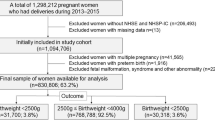Abstract
Purpose
To evaluate the long-term outcome of fetuses with a diagnosis of isolated short long bones.
Methods
A retrospective review was conducted of all cases diagnosed with short long bones above 20 weeks of gestation during 2010–2017 in a single tertiary center. Exclusion criteria included abnormal sonographic findings other than short long bones, suspected genetic syndromes, chromosomal abnormalities, and abnormal Doppler flow indices. Follow-up was carried out by telephone questionnaire.
Results
During the study period, 54 (24.32%) women met inclusion criteria. Mean gestational age at delivery was 38.05 years (± 2.42 SD). Mean birth weight was 12–19th percentile according to the local fetal growth charts [2645 g (± 684 SD) 95% CI 2173–2980]. Median time for post-natal follow-up was 9.3 years (IQR 6.6–10.75). Growth below the 10th percentile was demonstrated in 27 (50%) children. 11 (20.37%) children were followed up by endocrinological clinics, of them 7 (12.96%) were treated with growth hormone. Three (5.6%) of the children were diagnosed with attention deficit hyperactivity disorder, an incidence that is considered lower than that of the general population (± 9%).
Conclusions
Prenatal fetal isolated short long bones diagnosed during the late second and third trimester is associated with short stature. No neurodevelopmental impact was observed in our study group.
Similar content being viewed by others
References
Papageorghiou AT et al (2008) Outcome of fetuses with antenatally diagnosed short femur. Ultrasound Obstet Gynecol 31(5):507–511
Kaijomaa M et al (2016) Risk of adverse outcomes in euploid pregnancies with isolated short fetal femur and humerus on second-trimester sonography. J Ultrasound Med 35(12):2675–2680
Salomon LJ, Bernard JP (2008) Re: Outcome of fetuses with antenatally diagnosed short femur. Ultrasound Obstet Gynecol 32(5):719 (author reply)
Zalel Y et al (2002) Shortened fetal long bones: a possible in utero manifestation of placental function. Prenat Diagn 22(7):553–557
Todros T et al (2004) Fetal short femur length in the second trimester and the outcome of pregnancy. BJOG 111(1):83–85
Mathiesen JM et al (2014) Outcome of fetuses with short femur length detected at second-trimester anomaly scan: a national survey. Ultrasound Obstet Gynecol 44(2):160–165
Parilla BV et al (2003) Antenatal detection of skeletal dysplasias. J Ultrasound Med 22(3):255–258
Hadlock FP et al (1984) Estimating fetal age: computer-assisted analysis of multiple fetal growth parameters. Radiology 152(2):497–501
Hadlock FP et al (1985) Estimation of fetal weight with the use of head, body, and femur measurements—a prospective study. Am J Obstet Gynecol 151(3):333–337
CDC—Developmental milestones. https://www.cdc.gov/ncbddd/actearly/milestones/index.html
Israeli Ministry of Health. https://www.health.gov.il/Subjects/KidsAndMatures/Pages/curves.aspx
Dollberg S et al (2005) Birth weight standards in the live-born population in Israel. Isr Med Assoc J 7(5):311–314
Yinon G, Harel Y, Ofir K, Zilberberg E, Perlman S (2008) Sonographic fetal estimated weight significantly differs from neonatal weight in the same population. J Gynecol Womens Health. https://doi.org/10.19080/JGWH.2018.08.555741
Unterscheider J et al (2014) Definition and management of fetal growth restriction: a survey of contemporary attitudes. Eur J Obstet Gynecol Reprod Biol 174:41–45
Ernst SA et al (2018) Variation in the definition of intrauterine growth restriction in routine antenatal care: a physician survey among gynecologists in Northwest Germany. J Matern Fetal Neonatal Med 31(16):2141–2147
Vayssière C et al (2015) Fetal growth restriction and intra-uterine growth restriction: guidelines for clinical practice from the French College of Gynaecologists and Obstetricians. Eur J Obstet Gynecol Reprod Biol 193:10–18
Goetzinger KR et al (2012) Isolated short femur length on second-trimester sonography: a marker for fetal growth restriction and other adverse perinatal outcomes. J Ultrasound Med 31(12):1935–1941
Mailath-Pokorny M et al (2015) Isolated short fetal femur length in the second trimester and the association with adverse perinatal outcome: experiences from a tertiary referral center. PLoS ONE 10(6):e0128820
Ren Y et al (2017) Clinical analysis of 21 cases with short fetal femur in the third trimester. Zhonghua Fu Chan Ke Za Zhi 52(2):86–92
Pogue R et al (2017) Short stature, unusual face, delta phalanx, and abnormal vertebrae and ribs in a girl born to half-siblings. Am J Med Genet Part A 173(5):1152–1158
Song J, Wang X (2010) Prenatal diagnose of abnormalities of fetal limb bone. Zhonghua Fu Chan Ke Za Zhi 45(10):745–749
Galthen-Sørensen M et al (2014) Maternal 25-hydroxyvitamin D level and fetal bone growth assessed by ultrasound: a systematic review. Ultrasound Obstet Gynecol 44(6):633–640
Levy B, Wapner R (2018) Prenatal diagnosis by chromosomal microarray analysis. Fertil Steril 109(2):201–212
Author information
Authors and Affiliations
Contributions
AM: conception, planning, carrying out work, analyzing and writing the manuscript; ST: carrying out the work; MS: carrying out the work; SP: analyzing and writing, manuscript writing, manuscript editing; RA: conception, carrying out the work; YG: conception, manuscript writing, manuscript editing.
Corresponding author
Ethics declarations
Conflict of interest
The authors report no conflict of interest.
Ethical approval
The study protocol was approved by the Institutional Review Board (ID 3975-17-SMC) on 16/3/2017 before the study had begun.
Additional information
Publisher's Note
Springer Nature remains neutral with regard to jurisdictional claims in published maps and institutional affiliations.
Rights and permissions
About this article
Cite this article
Mohr-Sasson, A., Toussia-Cohen, S., Shapira, M. et al. Long-term follow-up on fetuses with isolated sonographic finding of short long bones: a cohort study. Arch Gynecol Obstet 301, 459–463 (2020). https://doi.org/10.1007/s00404-019-05421-4
Received:
Accepted:
Published:
Issue Date:
DOI: https://doi.org/10.1007/s00404-019-05421-4




